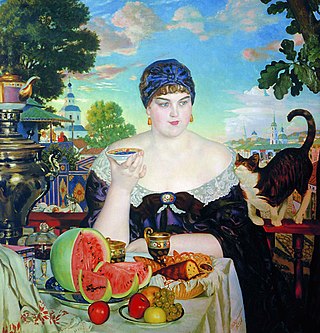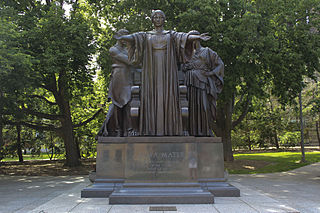A bachelor is a man who is not and never has been married.

Pussy is a term used as a noun, an adjective, and—in rare instances—a verb in the English language. It has several meanings, as slang, as euphemism, and as vulgarity. Most commonly, it is used as a noun with the meaning "cat", "coward", or "weakling". In slang usage, it can mean "vulva or vagina" and less commonly, as a form of synecdoche, meaning "sexual intercourse with a woman". Because of its multiple senses including both innocent and vulgar connotations, pussy is often the subject of double entendre.

A wife is a woman in a marital relationship. A woman who has separated from her partner continues to be a wife until their marriage is legally dissolved with a divorce judgment. On the death of her partner, a wife is referred to as a widow. The rights and obligations of a wife to her partner and her status in the community and law vary between cultures and have varied over time.

A nuclear family is a family group consisting of parents and their children, typically living in one home residence. It is in contrast to a single-parent family, a larger extended family, or a family with more than two parents. Nuclear families typically center on a married couple which may have any number of children. There are differences in definition among observers. Some definitions allow only biological children who are full-blood siblings and consider adopted or half- and step-siblings a part of the immediate family, but others allow for a step-parent and any mix of dependent children, including stepchildren and adopted children. Some sociologists and anthropologists consider the extended family structure to be the most common family structure in most cultures and at most times, rather than the nuclear family.
Lady is a term for a girl or woman, with various connotations. Once used to describe only women of a high social class or status, the female counterpart of lord, now it may refer to any adult woman, as gentleman can be used for men. Informal use is sometimes euphemistic.
Mrs. or Mrs is a commonly used English honorific for women, usually for those who are married and who do not instead use another title, such as Doctor, Professor, President, Dame, etc. In most Commonwealth countries, a full stop (period) is usually not used with the title. In the United States and Canada a period is usually used.

A cordwainer is a shoemaker who makes new shoes from new leather. The cordwainer's trade can be contrasted with the cobbler's trade, according to a tradition in Britain that restricted cobblers to repairing shoes. This usage distinction is not universally observed, as the word cobbler is widely used for tradespersons who make or repair shoes.
Bachelorette (/ˌbætʃələˈrɛt/) is a term used in American English for a single, unmarried woman. The term is derived from the word bachelor, and is often used by journalists, editors of popular magazines, and some individuals. "Bachelorette" was famously the term used to refer to female contestants on the old The Dating Game TV show and, more recently, The Bachelorette.
In legal definitions for interpersonal status, a single person refers to a individual who is not in committed relationships, or is not part of a civil union. In common usage, the term single is often used to refer to someone who is not involved in either any type of sexual relationship, romantic relationship, including long-term dating, engagement, marriage, or someone who is "single by choice". Single people may participate in dating and other activities to find a short-term partner or spouse.

A mistress is a woman who is in a relatively long-term sexual and romantic relationship with someone who is married to a different person.

Catherinette was a traditional French label for a woman of twenty-five years who was still unmarried by the Feast of Saint Catherine. A special celebration was offered to them on this day and everyone wished them a swift end to their single status.
In the lineal kinship system used in the English-speaking world, a niece or nephew is a child of an individual's sibling or sibling-in-law. A niece is female and a nephew is male, and they would call their parents' siblings aunt or uncle. The gender-neutral term nibling has been used in place of the common terms, especially in specialist literature.

Merriam-Webster's Words of the Year are words of the year lists published annually by the American dictionary-publishing company Merriam-Webster, Inc. The lists feature ten words from the English language. These word lists started in 2003 and have been published at the end of each year.

Alumni are former students or graduates of a school, college, or university. The feminine plural alumnae is sometimes used for groups of women, and alums or alumns as gender-neutral alternatives. The word comes from Latin, meaning nurslings, pupils or foster children, derived from alere "to nourish".

The shrew – an unpleasant, ill-tempered woman characterised by scolding, nagging, and aggression – is a comedic, stock character in literature and folklore, both Western and Eastern. The theme is illustrated in Shakespeare's play The Taming of the Shrew.
A matrifocal family structure is one where mothers head families and fathers play a less important role in the home and in bringing up children.
Sheng nu, translated as 'leftover women' or 'leftover ladies', are women who remain unmarried in their late twenties and beyond in China. The term was popularized by the All-China Women's Federation. Most prominently used in China, the term has also been used colloquially to refer to women in India, North America, Europe, and other parts of Asia. The term compares unmarried women to leftover food and has gone on to become widely used in the mainstream media and has been the subject of several television series, magazine and newspaper articles, and book publications, focusing on the negative connotations and positive reclamation of the term. While initially backed and disseminated by pro-government media in 2007, the term eventually came under criticism from government-published newspapers two years later. Xu Xiaomin of The China Daily described the sheng nus as "a social force to be reckoned with" and others have argued the term should be taken as a positive to mean "successful women". The slang term, 3S or 3S Women, meaning "single, seventies (1970s), and stuck" has also been used in place of sheng nu.
In South Korea, a gold miss (Korean: 골드미스) is an unmarried woman with a high socioeconomic status and level of education. These women frequently have a long career and enjoy being single as a result of social changes that have made marriage later in life common and reduced gender discrimination in the work place. They are also interested in developing themselves and their skills. They frequently spend much money shopping and enjoying trips overseas. They do not prioritise love or marriage in their lives.

During the Middle Ages in Europe, lifelong spinsters came from a variety of socioeconomic backgrounds, though elite women were less likely to be single than peasants or townswomen. The category of single women does not include widows or divorcees, which are terms used to describe women who were married at one point in their lives.
Amatonormativity is the set of societal assumptions that everyone prospers with an exclusive romantic relationship. Elizabeth Brake coined the neologism to capture societal assumptions about romance. Brake wanted to describe the pressure she received by many to prioritize marriage in her own life when she did not want to. Amatonormativity extends beyond social pressures for marriage to include general pressures involving romance.












